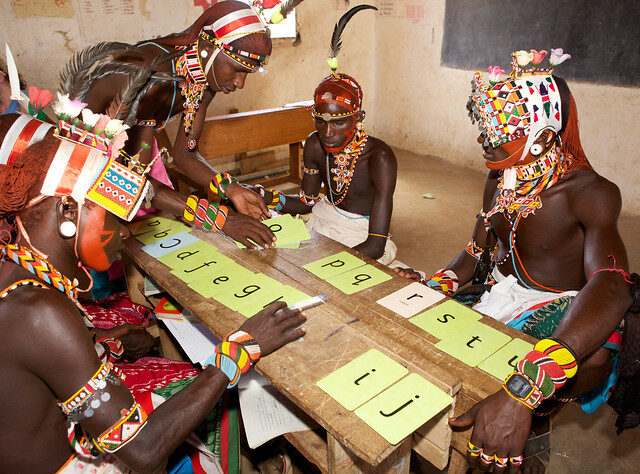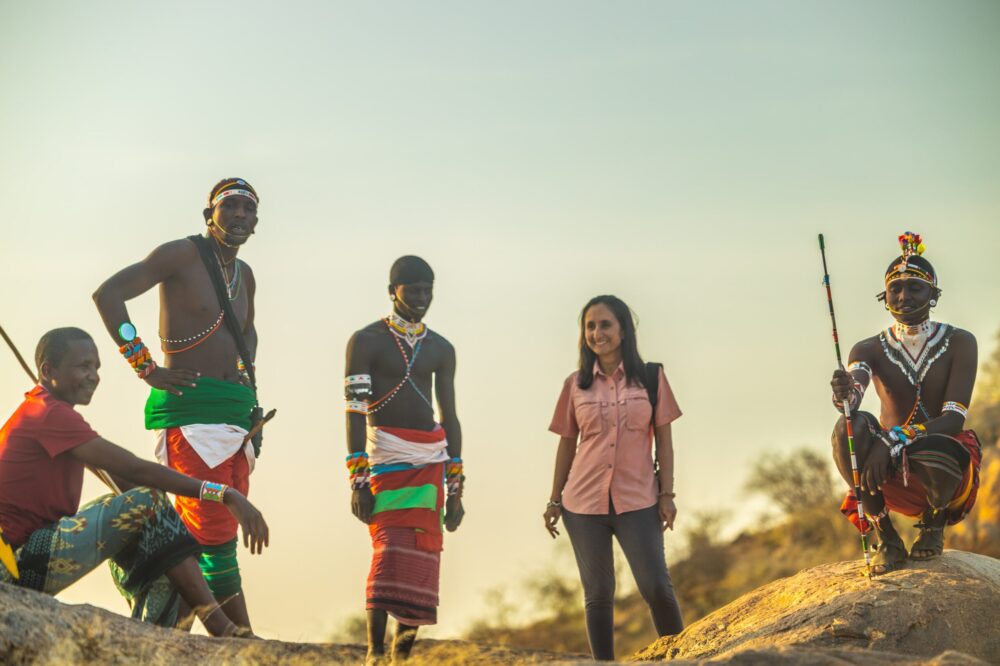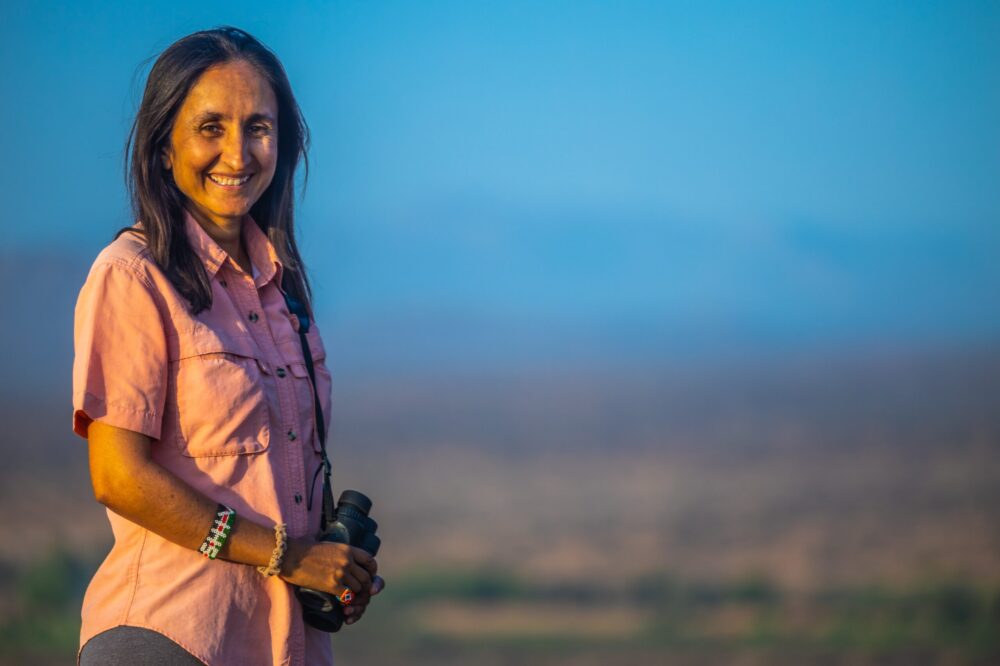Samburu Warriors Are Safeguarding Kenya’s Lions
By Kari Mutu
Community-based program engages pastoralists in conservation work to reduce human-wildlife conflicts.
Among the Samburu people, a pastoral tribe of north-central Kenya, warriors have traditionally hunted lions to prove their bravery or to protect their cattle, which form the basis of wealth and social rank in the community. But for nine years now, Jeneria Lekilelei, a Samburu warrior, has been doing the opposite, working to protect lions from being killed by his own people.
Lekilelei, 27, dropped out of high school many years ago for lack of funds. Most of his adolescent years were spent herding the cattle within the Westgate Conservancy, a community-owned group ranch that boarders the semi-arid Samburu National Reserve. In 2008, when he was 19, he joined Ewaso Lions, a conservation group based in the Conservancy, as a field data collector. At the time, he knew nothing about lions and found the idea of protecting the large carnivores shocking.
Founded in 2007 by conservation biologist Shivani Bhalla, Ewaso Lions works to protect Kenya’s wildlife by involving communities in solutions that promote peaceful coexistence between people and wild animals. The organization fills a critical need in the country: According to Ewaso, Africa’s lion population has declined by some 90 percent over the past 75 years, primarily due to loss of habitat and human-animal conflict. In Kenya, there are fewer than 2,000 lions left.
Bhalla quickly realized that understanding lion movements throughout the park, and beyond, was essential to the conservation work. “We’d see lions, then they’d disappear. Clearly, they were going outside the park,” Bhalla says. “I realized we need[ed] to be living outside and understanding whether lions and people can actually live together.” In need of more information in order to create solutions for protecting lions, she shifted her focus from the park to surrounding community lands and recruited three young Samburu men to assist her, including Lekilelei.
In the first year working for Ewaso Lions, Lekilelei quietly recorded general field information about the ecology and different kinds of animals in the area surrounding Samburu and hardly spoke a word to Bhalla. In his second year, he accompanied her on a research trip to the Shaba National Reserve, an even drier and more rugged region of Samburu. For a week, he sat on a vehicle roof under the scorching sun searching for lions. Undeterred by the heat or rough conditions, he was animated by the work, and not long after the trip, Bhalla offered him a job as a lion scout, to track their numbers, movements, and cases of human-wildlife conflict. He seized the opportunity and has never looked back.
To expand Ewaso Lion’s fieldwork program, Lekilelei came up with the idea of recruiting more Samburu warriors. Nobody, after all, knows the landscape better than they do.
In 2010, the organization expanded further by establishing Warrior Watch, a program of twenty-odd Samburu youth engaged as ambassadors for wildlife. The additional warriors were trained on how to identify individual lions, monitor problem animals, collect data, and conduct wildlife surveillance through GPS, camera traps, vehicle patrols, and old-fashioned tracking.
Dressed in their traditional attire and beaded jewellery, the expanded team of warriors conduct bush patrols every day, liaise with herders, carry out anti-poaching work, and spread conservation awareness in what has become an extension of their traditional role as guardians of the community.
Because harm to livestock is a major source of human-wildlife conflicts in the region, Warrior Watch responds quickly to predation events to speak with the affected people, avert retaliatory killings, and help recover missing animals. Responders also support families to improve their animal husbandry practices and minimize the risk of wildlife attacks. In return, the warriors receive stipends, meals, and basic education since many of them did not complete school.
 photo by Tyrel Bernardini: Samburu warriors receive lessons in reading and writing, along with stipends and meals, for thier work with Ewaso Lions.
photo by Tyrel Bernardini: Samburu warriors receive lessons in reading and writing, along with stipends and meals, for thier work with Ewaso Lions.
The warriors have developed a special bond with the lions of Samburu. One of their favorites is a 16-year old lioness called Nashipai. Unfortunately, Nashipai has a penchant for attacking domestic animals. “She’s got no teeth. I think that’s why she is going after easier prey,” explains Bhalla. “But … [the warriors have] saved her hundreds of times. Every time someone wants to kill her, they are there.”
Over the years Lekilelei and Bhalla have come to realize that the future of lions depends on changing the attitudes of those who only come into contact with wildlife following attacks on their cows and goats. “My community was killing [lions] for lack of understanding. All they want to do is to reduce a problem to their livestock,” explains Lekilelei, now the field operations and community manager for Ewaso Lions. “Warriors want to hold onto their culture by killing a lion, that’s what is in their minds,” he adds.
Consequently, Lekilelei sees his role as that of educating the community and preserving the Samburu culture in ways that protect wildlife and their habitats. “You tell them that there are only like 10 lions in the whole of Samburu area, that lions are going to be extinct if we can’t conserve,” he explains.
In his new role, he participates in discussions with the local elders who are the decision-makers of the community. The elders often reminisce about the disappearance of rhino in Samburu because of hunting and poaching in the 1970s and 1980s. They would not wish to see lions go the same way. Lekilelei and the Ewaso team also interact with women and children who have historically been left out of the conservation discussion.
Ewaso Lions has expanded since 2007, and is now working in the Kalama, Nakuprat Gotu, and Ol Donyiro Community Conservancies of Samburu as well as Westgate, an area covering over 5,000 square kilometres and home to the third largest population of lions in the country.
The large study area allows the organization to explore the connectivity between different regions in the wider Samburu ecosystem and how lions disperse through existing corridors, information that can help inform conservation work. Lions will habitually migrate to find ideal conditions for food and water. Unfortunately, human development, new roads, and new settlements coming into marginal areas are cutting off traditional migration routes for lions and other wildlife. “The main thing is to make sure the corridors are kept open,” Bhalla says.

photo courtesy of Ewaso Lions: A lion in Samburu National Reserve.
Lion numbers in the region have increased since Ewaso Lions began its work in 2007.
As the organization has grown, Westgate has served as a sort of laboratory for Ewaso Lions to test different conservation program with the local community. Since the start of their work nine years ago, Bhalla estimates that the lion population has grown from 11 individuals to around 50 animals moving in and out of Westgate, and that numbers are stable at present. She is confident that the Westgate lions are safe for now because of successful wildlife management models based on community partnerships.
Just last year they heard lions roaring in Westgate conservancy for the first time, a rare occurrence outside of state parks. “That’s a sign that they feel safe. It’s exciting for us that even a lion can sense that there’s a change out here,” said Bhalla.
Nevertheless, challenges do remain, such as the building of national infrastructure in Samburu County. During years of drought, nomadic people from other areas frequently move into Samburu lands in search of pasture. “They come from far away where conservation hasn’t reached and people still practice killing of lions,” explains Lekilelei.
The future plan for Ewaso Lions is to replicate the Westgate model elsewhere and to engage with other communities living in lion habitats in order to build up tolerance for wildlife.
“I am very proud to see how we have changed the whole face of the community towards conservation,” says Bhalla. “Warriors who were hunters or killers of lions have become conservationists.”
The original article posted to the Earth Island Journal can be accessed here: https://www.earthisland.org/journal/index.php/articles/entry/samburu_warriors_are_safeguarding_kenyas_lions





